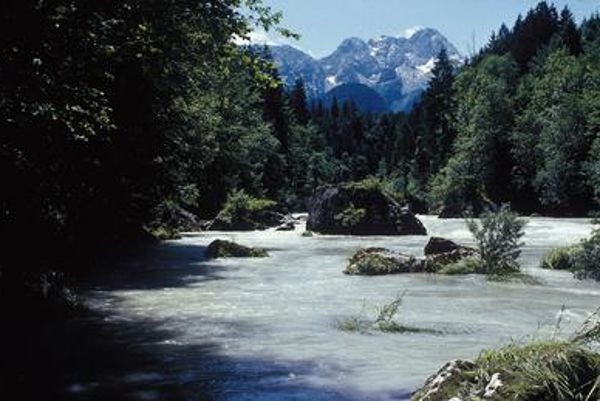Environmental goals - the good status for our waters

The good status is the water status, which shall be reached in all surface and groundwater bodies.
For surface waters the generation of the “good status” and/or the “good potential” is the target according to the European Water Framework Directive (imperative to achieve an enhancement).
As far as groundwater is concerned, the “good chemical and quantitative status” has to be reached.
Furthermore, it is stipulated that the status of the bodies of water must not be deteriorated (principle of non-deterioration).
Waters are in a good status if their communities, their structure, the chemical ingredients (surface waters) and/or their quantity and the chemical ingredients (groundwater) are only slightly influenced by humans.
Surface waters
The good status of a surface water body is composed of an at least good ecological and chemical status.
The underlying concept of the term ecological status is the water quality in relation to the structure and functionality of aquatic ecosystems.
Assessed is the ecological status with respect to
- the composition and the quality of the living community in water,
- Nationally relevant chemical pollutants as well as
supplementary regarding the
- physical-chemical components such as availability of nutrients, content of oxygen, temperature, salt content and the
- hydro-morphological characteristics such as water volume, current, depth and condition of the riverbed.
Due to the different characteristics of waters, various small animals, algae, water plants and fish are living there. The composition of the community of these biological quality elements reflects the quality of the bodies of water.
Assessment in 5 classes
According to the EU WFD, surface waters are subdivided according to their ecological status into five classes:
- High
- Good
- Moderate
- Poor
- Bad
Water ecology is type-specific and decisively marked by the interplay of biological, chemical and hydro-morphological components. These components are, according to the Water Framework Directive, to be applied as well for the assessment of the ecological status. The assessment takes place on the basis of the deviation of the water body from the natural status, largely unaffected by human interference (reference status), via a 5-class assessment system.
The determination of the threshold values for the five classes of ecological status took place gradually. In a first step, the very different bodies of water were subdivided into comparable types and the respective reference conditions typical for the type of water body were described. On the basis of this first step, 5-class assessment schemes for the biological quality elements (small elements, algae, water plants and fish) have been established and investigation methods have been worked out.
In order to make sure that the biological assessment systems applied are also comparable on a European scale, the procedures were synchronised between the Member States within the framework of the so-called inter-calibration.
The classification “high” takes place if, due to the biological, chemical morphological conditions one can proceed on the assumption that no or only very little interferences by humans take place and that the status is near-natural. The water quality corresponds to the degree of the deviation from the reference status, a “good status“ deviates slightly, a “moderate” more etc.
Apart from the naturally developed water bodies there are also “artificial” water bodies or water bodies which have been “considerably modified” by human interference. They have a special status because due to the severe interferences and changes no recovery to a good status is possible without leading to a disproportionately high restriction of human activities and utilisations. In this case, the goal is to reach the good ecological potential.
For the purpose of defining the chemical status the EU has laid down environmental quality standards for priority substances and previously regulated substances. These substances are considered to be substances of concern in the whole EU area. The compliance with the requirements laid down in the standards are measured in water, in deposits or fauna/flora. There is a good chemical status, if no pollutant occurs in a higher concentration than permitted in the environmental quality standards.
Groundwater
As to groundwater, the approach is quite different. In this case a good chemical and quantitative status shall be reached.
On the basis of geological data, the quantity of groundwater must be determined. According to law, the water abstraction is restricted to a share of the groundwater newly generated by year. There exists a good quantitative status if the mean annual water abstraction does not exceed the available resources on the long run.
For the description of the chemical quality of groundwater characteristic reference parameters, nutrients and other parameters, such as heavy metals or plant protection products, are measured. There exists a good chemical status in groundwater, if the concentration of certain pollutants complies with the applicable quality standards and the anthropogenic material pollution doesn’t result in a significant damage of surface water bodies or wetlands.
Another very important environmental objective of the EU WFD is that the status of waters must not be deteriorated (principle of non-deterioration).
The EU Member States have to lay down “uniform and significant stretches” of a water body. These water bodies are e.g. sub-sections of a river, a lake or a delimited groundwater volume within one or several aquifers (or aquifer = solid rock or sediment which stores and can transport groundwater). The subdivision is based on the classification and the water status. Moreover, bodies of water shall support a targeted management of waters.